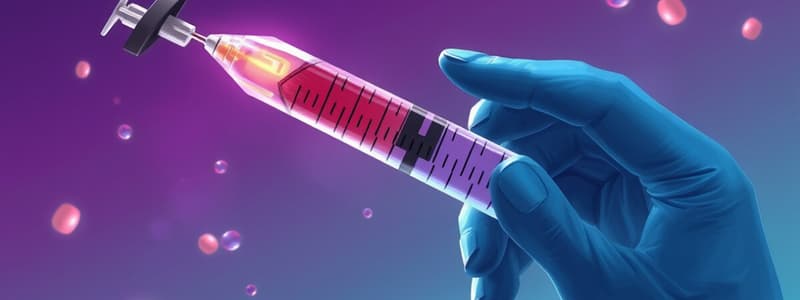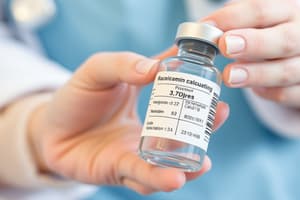Podcast
Questions and Answers
What is the primary function of lyophilization in the context of drying powdered products?
What is the primary function of lyophilization in the context of drying powdered products?
Which of the following is NOT a requirement for vehicles used in parenteral injections?
Which of the following is NOT a requirement for vehicles used in parenteral injections?
Which component is primarily prohibited from use in parenteral ingredients?
Which component is primarily prohibited from use in parenteral ingredients?
What is the first step in the lyophilization process?
What is the first step in the lyophilization process?
Signup and view all the answers
Which type of water is specifically designed for injections?
Which type of water is specifically designed for injections?
Signup and view all the answers
Which of the following is NOT considered a tonicity material for injections?
Which of the following is NOT considered a tonicity material for injections?
Signup and view all the answers
What characteristic must solvents for injection possess?
What characteristic must solvents for injection possess?
Signup and view all the answers
What is a quality that all vehicles for parenteral injections must have?
What is a quality that all vehicles for parenteral injections must have?
Signup and view all the answers
Which description best fits small volume parenterals (SVP)?
Which description best fits small volume parenterals (SVP)?
Signup and view all the answers
What is a potential consequence of chemical incompatibility in injections?
What is a potential consequence of chemical incompatibility in injections?
Signup and view all the answers
Which of the following factors can help prevent incompatibilities in injections?
Which of the following factors can help prevent incompatibilities in injections?
Signup and view all the answers
Which statement is true regarding large volume parenterals (LVP)?
Which statement is true regarding large volume parenterals (LVP)?
Signup and view all the answers
What is one characteristic of premixed small volume parenterals?
What is one characteristic of premixed small volume parenterals?
Signup and view all the answers
Which of the following is NOT a typical consequence of physical incompatibility?
Which of the following is NOT a typical consequence of physical incompatibility?
Signup and view all the answers
What is the primary purpose of large volume parenterals?
What is the primary purpose of large volume parenterals?
Signup and view all the answers
Which of the following statements about storage conditions is true for injections?
Which of the following statements about storage conditions is true for injections?
Signup and view all the answers
What is the primary purpose of using Large-Volume Parenterals (LVP) for maintenance therapy?
What is the primary purpose of using Large-Volume Parenterals (LVP) for maintenance therapy?
Signup and view all the answers
Which components are included in Total Nutrient Admixtures (TNA)?
Which components are included in Total Nutrient Admixtures (TNA)?
Signup and view all the answers
For patients experiencing severe dehydration due to vomiting or diarrhea, what is the recommended water requirement per kilogram?
For patients experiencing severe dehydration due to vomiting or diarrhea, what is the recommended water requirement per kilogram?
Signup and view all the answers
What do Large-Volume Parenterals help substitute in patients with heavy losses of bodily fluids?
What do Large-Volume Parenterals help substitute in patients with heavy losses of bodily fluids?
Signup and view all the answers
In cases where oral feeding is postponed for weeks, what type of nutrition is typically provided?
In cases where oral feeding is postponed for weeks, what type of nutrition is typically provided?
Signup and view all the answers
What is the purpose of refrigeration in the context of antimicrobial agents?
What is the purpose of refrigeration in the context of antimicrobial agents?
Signup and view all the answers
Which of the following is NOT a reason to implement tonicity agents in parenteral formulations?
Which of the following is NOT a reason to implement tonicity agents in parenteral formulations?
Signup and view all the answers
Which microbial organisms were used to test the effectiveness of an antimicrobial system?
Which microbial organisms were used to test the effectiveness of an antimicrobial system?
Signup and view all the answers
What is a key indicator that an antimicrobial agent added was effective?
What is a key indicator that an antimicrobial agent added was effective?
Signup and view all the answers
Which of the following is NOT a potential tonicity agent mentioned?
Which of the following is NOT a potential tonicity agent mentioned?
Signup and view all the answers
What is the primary purpose of using water-miscible vehicles in drug formulations?
What is the primary purpose of using water-miscible vehicles in drug formulations?
Signup and view all the answers
What pH range can lead to tissue necrosis when using injectable formulations?
What pH range can lead to tissue necrosis when using injectable formulations?
Signup and view all the answers
Which of the following is NOT considered a water-miscible solvent?
Which of the following is NOT considered a water-miscible solvent?
Signup and view all the answers
Which of these agents is used to prevent microbial growth in drug formulations?
Which of these agents is used to prevent microbial growth in drug formulations?
Signup and view all the answers
What consequence can occur if the pH of an injectable formulation is above 9.0?
What consequence can occur if the pH of an injectable formulation is above 9.0?
Signup and view all the answers
What is the main function of antioxidants in pharmaceutical formulations?
What is the main function of antioxidants in pharmaceutical formulations?
Signup and view all the answers
Which type of vehicles are described as pure, sterile, and pyrogen free, and used for IM injections?
Which type of vehicles are described as pure, sterile, and pyrogen free, and used for IM injections?
Signup and view all the answers
Which one of the following is a potential risk when using nonaqueous vehicles?
Which one of the following is a potential risk when using nonaqueous vehicles?
Signup and view all the answers
What is a major consideration when adding buffers to pharmaceutical formulations?
What is a major consideration when adding buffers to pharmaceutical formulations?
Signup and view all the answers
Which of the following is an example of a water-soluble antioxidant?
Which of the following is an example of a water-soluble antioxidant?
Signup and view all the answers
Study Notes
Parenteral Incompatibility
- Physical incompatibility: Visible changes in solution appearance like precipitation, color change, or gas formation.
-
Chemical incompatibility: Chemical changes leading to toxicity or therapeutic inactivity, not always visible.
- Includes hydrolysis, complexation, oxidation, photolysis, and API reacting with light.
- Therapeutic incompatibility: Change in activity, like cortisone antagonizing heparin.
- Preventing incompatibilities: Control factors that lead to incompatibility.
Available Injections
- Hundreds of injections available.
-
Small Volume Parenterals (SVP) (25-50 mL).
- Can be solutions, suspensions, emulsions, or solids.
- Premixed, ready-to-use, requiring little or no manipulation.
- Little wastage.
- Limited flexibility in quantity/concentration.
- Some products require thawing, possibly in a microwave.
-
Large Volume Parenterals (LVP)
- Flexible but requires manipulation, requiring sterility.
- Usually for intravenous infusion to replenish body fluids, electrolytes, or provide nutrition.
- Volume: 100 mL-1 L or more per day.
- Should not contain bacteriostatic or pharmaceutical additives, including coloring agents.
- Must meet standards for particulate matter.
- Packaged in hermetic containers of high quality.
- Filled in slight excess for easy withdrawal.
- Sterilized powders for solutions/suspensions are packed as lyophilized or freeze-dried.
- Specific labeling regulations apply.
Lyophilization (Freeze-drying)
- Process of drying where water is sublimed from the product after freezing.
- Steps:
- Freezing an aqueous product.
- Evacuate the chamber using a vacuum.
- Introduce heat to sublimate ice into a cold condensing surface.
Parenteral Ingredients/Necessities
- Vehicle: Depends on the dosage form used.
- Buffers: Maintain pH, stability, and prevent degradation.
- Antioxidants: Prevent oxidation by blocking the process or being oxidized faster than the drug.
- Antibacterial agents: Prevent microbial growth and multiplication.
- Tonicity materials: Dextrose, glycerin, mannitol, NaCl. Ensure cells do not expand or shrink and maintain volume.
- Surfactants: Egg and soybean phospholipids and lecithin.
- Thickeners.
- Preservatives: Used in multi-dose containers.
- Solubilizers, protectants, wetting agents, emulsifiers, local anesthetics, etc.
- Do not use color.
Vehicles for Injection
- Solvent criteria: Non-irritating, non-toxic, non-sensitizing, no pharmacological activity, and does not affect the medicinal agents' activity.
- Must be sterile, particle, and pyrogen-free.
-
Aqueous Vehicles:
- Water is the most frequently used and preferred.
- Types of water for injections:
- Water for Injection USP/Purified Water USP.
- Sterile Water for Injection USP (SWFI).
- Bacteriostatic Water for Injection USP.
- Sterile Water for Irrigation.
-
Water-miscible vehicles:
- Ethanol, propylene glycol, polyethylene glycol 300.
- Used to increase drug solubility and/or reduce hydrolysis.
-
Nonaqueous Vehicles:
- Pure, sterile, pyrogen-free, and particulate-free.
- Must remain clear when cooled to 10°C.
- Primarily used for intramuscular injections.
- Can be irritating and cause allergic reactions.
- Examples: Peanut oil (dimercaprol), cottonseed oil (estradiol cypionate), castor oil (estradiol valerate).
Buffers
- Maintain pH, stability, and prevent degradation.
- Considerations: chemical interactions and effective pH range.
- Blood pH: 7.4.
- pH > 9.0 can cause tissue necrosis.
- pH < 3.0 can cause extreme pain and phlebitis.
Antioxidants
- Prevent the oxidation process by:
- Blocking the process.
- Being oxidized faster than the drug.
- Examples (water-soluble): Ascorbic acid, sodium sulfite, sodium bisulfite.
- Examples (oil-soluble): Butylated hydroxytoluene and hydroxyanisole.
- Displace air with inert gas (N2) to prevent oxidation.
Antibacterial Agents
- Prevent microbial growth and multiplication.
- Use limited concentrations of antibacterial agents.
- Mercury reagents: Phenylmercuric nitrate 0.01%.
- Chlorobutanol, phenol, or cresol 0.5%.
- Effectiveness varies with formulation.
- Refrigeration slows growth but does not prevent it.
Antibacterial Agents Testing
- Determine the effectiveness of an antimicrobial system for parenteral:
- Inoculate with a known number of organisms (Candida albicans, Aspergillus niger, Escherichia coli, Pseudomonas aeruginosa, and Staphylococcus aureus).
- Incubate at 32°C and examine.
- An effective antibacterial agent will result in no significant increase in microorganisms.
Tonicity Agents
- Ensure cells don't expand or shrink, maintaining cell volume.
- Routes requiring isotonicity: Intrathecal, intraarticular, and intradermal.
- Reduce pain of injection and tissue irritation.
- Reduce hemolysis of blood cells.
- Prevent electrolyte imbalance.
- Include buffers.
- Examples: Sodium chloride (0.9%), potassium chloride, dextrose (5.5%), mannitol, sorbitol, lactose.
Protectants
- Maintain the structure of certain APIs.
- Contain electrolytes, carbohydrates, and nutritional components like proteins and fatty emulsions.
Large-Volume Parenterals (LVP)
- Used for maintenance and replacement therapy.
Maintenance Therapy
- For surgery patients, recovering patients, and unconscious patients.
- Provides all essential nutrients to minimize tissue breakdown and maintain normalcy.
- Total parenteral nutrition (TPN) provided if oral feeding is impossible.
- Total nutrient admixtures (TNA) include all substrates necessary for nutritional support.
- Nutrients are mixed in a single IV bag for convenient administrations.
Replacement Therapy
- Replaces losses of water and electrolytes due to conditions like vomiting, diarrhea, burns, and AIDS.
- Includes:
- Water requirements: 25-40 mL/kg.
- Electrolyte requirements: K 100 mEq; Na 135-170 mEq.
- Caloric requirements: 5% dextrose.
Studying That Suits You
Use AI to generate personalized quizzes and flashcards to suit your learning preferences.
Related Documents
Description
This quiz explores parenteral incompatibilities, focusing on physical, chemical, and therapeutic aspects. It also covers available injections, including Small Volume and Large Volume Parenterals, and their characteristics. Understand the factors that contribute to incompatibility and how to prevent them.



